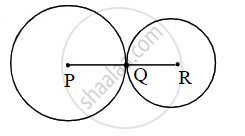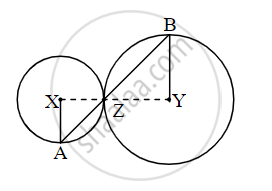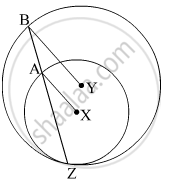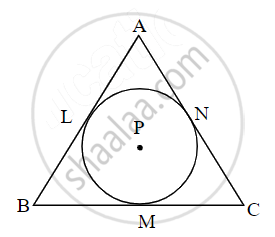Advertisements
Advertisements
प्रश्न
Two circles of radii 5.5 cm and 4.2 cm touch each other externally. Find the distance between their centres.
उत्तर
Let the two circles having centres P and R touch each other externally at point Q.

Here, PQ = 5.5 cm, QR = 4.2 cm
The two circles touch each other externally. ...(P−Q−R)
If the circles touch each other externally, distance between their centres is equal to the sum of their radii.
∴ By theorem of touching circles,
∴ PR = PQ + QR
∴ PR = 5.5 + 4.2
∴ PR = 9.7 cm
∴ The distance between the centres of the circles is 9.7 cm.
APPEARS IN
संबंधित प्रश्न
If two circles with radii 5 cm and 3 cm respectively touch internally, find the distance between their centres.
If two circles with radii 8 cm and 3 cm, respectively, touch internally, then find the distance between their centers.
If two circles with radii 8 cm and 3 cm respectively touch externally, then find the distance between their centres.
If radii of two circles are 4 cm and 2.8 cm. Draw a figure of this circles touching each other externally.
In the given figure, the circles with centres P and Q touch each other at R. A line passing through R meets the circles at A and B respectively. Prove that – (1) seg AP || seg BQ,
(2) ∆APR ~ ∆RQB, and
(3) Find ∠ RQB if ∠ PAR = 35°
Four alternative answers for the following question is given. Choose the correct alternative.
Chords AB and CD of a circle intersect inside the circle at point E. If AE = 5.6, EB = 10, CE = 8, find ED.
How many common tangents can be drawn to two circles which touch each other internally?
(A) One (B) Two (C) Three (D) Four
In the adjoining figure circles with centres X and Y touch each other at point Z. A secant passing through Z intersects the circles at points A and B respectively. Prove that, radius XA || radius YB. Fill in the blanks and complete the proof.

Construction: Draw segments XZ and YZ.
Proof:
By theorem of touching circles, points X, Z, Y are `square`.
∴ ∠XZA ≅ `square` ...(opposite angles)
Let ∠XZA = ∠BZY = a ...(I)
Now, seg XA ≅ seg XZ ...[Radii of the same circle]
∴∠XAZ = `square` = a ...[isosceles triangle theorem](II)
Similarly,
seg YB ≅ seg YZ ...[Radii of the same circle]
∴∠BZY = `square` = a ...[isosceles triangle theorem](III)
∴ from (I), (II), (III),
∠XAZ = `square`
∴ radius XA || radius YZ ...[`square`]
In the given figure, circles with centres X and Y touch internally at point Z . Seg BZ is a chord of bigger circle and it itersects smaller circle at point A. Prove that, seg AX || seg BY.

Draw circles with centres A, B and C each of radius 3 cm, such that each circle touches the other two circles.
In the given figure, circles with centres C and D touch internally at point E. D lies on the inner circle. Chord EB of the outer circle intersects inner circle at point A. Prove that, seg EA ≅ seg AB.

If two circles with diameters 8 cm and 6 cm respectively touch externally, find the distance between their centers.
Two circles of radii 5.5 cm and 3.3 cm respectively touch each other externally. What is the distance between their centres?
Four alternative answers for the following question is given. Choose the correct alternative.
Two circles having diameters 8 cm and 6 cm touch each other internally. Find the distance between their centres.
Line ℓ touches a circle with center O at point P. If the radius of the circle is 9 cm, answer the following.

If d(O, Q) = 8 cm, where does the point Q lie?
A circle with centre P is inscribed in the ∆ABC. Side AB, side BC, and side AC touch the circle at points L, M, and N respectively. The radius of the circle is r.

Prove that: A(ΔABC) = `1/2` (AB + BC + AC) × r
